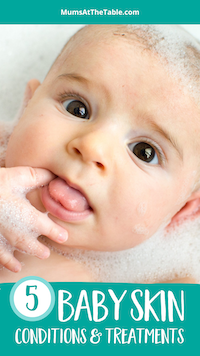Exploring the top five most common baby skin conditions—from nappy rash to eczema—with tips on how to manage them effectively.
Baby skin is the smoothest and silkiest until it’s not. Because their skin is so delicate, they are more susceptible to various skin conditions that can cause worry for parents. In fact, many new parents are alarmed by the various skin conditions their babies experience in the early months and years of life.
Thankfully, most baby skin conditions are harmless and easily treatable. Understanding these conditions and knowing the best ways to care for your baby’s skin can help keep it healthy, soft and irritation-free.
Whether you’re a new or seasoned parent, this guide will equip you with essential knowledge for managing your baby’s skin concerns.
1. Baby acne
Baby acne is a common skin condition affecting newborns in the first few weeks of life. It typically appears on the baby’s face and neck, resembling small red or white pimples, with possible slight swelling.
Causes
Baby acne is thought to be caused by maternal hormones passed to the baby during pregnancy right before birth. It usually resolves on its own in a few days or weeks, and doesn’t need any treatment.
How to manage
- Gentle cleaning: Alternate washing the affected area with warm water and a mild baby facial soap every other day. Never use adult skin products or cleansers, even if it’s a mild soap.
- Avoid scrubbing: Do not scrub or pick the pimples. This can cause infection and irritation. Do not apply any over-the-counter acne treatments, as they are unsuitable for your baby’s sensitive skin.
- Dry: Dry your baby’s face with a clean cloth by gently patting it.
2. Cradle cap (seborrheic dermatitis)
Cradle cap, or seborrheic dermatitis, is a condition that generally affects a baby’s scalp. It appears as crusty and scaly yellowish patches that may be oily or dry. Though it might look concerning, cradle cap is not painful or itchy.
Causes
Cradle cap is thought to be caused either by skin inflammation or by hormones from the mother. These hormones cross the placenta before birth, causing the oil glands in the baby’s skin to become overactive. As more oil is produced, the dead skin cells that would usually fall off stick to the skin, forming little scales.
How to manage
- Gentle shampooing: Wash your baby’s scalp with a mild baby shampoo.
- Soft brushing: While the shampoo is lathered on the scalp, use a soft brush to gently loosen the flakes from your baby’s hair.
- Oil treatment: If the scales are very hard, you can apply a small amount of baby oil to the scalp to soften them. Do this 15 minutes before bath time and then wash off.
3. Nappy rash or diaper rash or diaper dermatitis
Nappy or diaper rash is one of the most common skin problems in young children. It causes inflamed, red skin in the nappy area due to prolonged exposure to wetness, faeces and friction. The skin is very irritated and can cause the baby a lot of pain. Nappy rash is also sometimes caused by a bacterial or fungal infection.
Causes
- Prolonged exposure to moisture in the nappy area.
- Skin sensitivity to the nappy or wipes.
- Fungal infections such as candida.
How to manage
- Frequent nappy changes: Don’t allow your baby to sit in a wet or dirty nappy. Promptly change the nappy, washing or wiping the area clean.
- Air exposure: For short periods, let your baby go without a nappy to allow their skin to breathe.
- Barrier creams: Apply a thick layer of nappy rash cream to help prevent stinging and heal the broken skin.
- Warm water: Use warm water and mild baby soap to gently clean the nappy area.
- Anti-fungal cream: If a fungal infection is present, your doctor may recommend an anti-fungal cream.
4. Eczema (atopic dermatitis)
Eczema, also known as atopic dermatitis, is a skin condition that causes dry, itchy and inflamed skin. It can affect the face, arms and body. The skin can become cracked and painful, and it can linger chronically through childhood.
Causes
Eczema is often linked to allergies or asthma. Foods like dairy products, gluten, soy, nuts or eggs can be significant drivers of eczema. Certain environmental factors like heat, rough fabrics or harsh soaps can also trigger it.
How to manage
- Address allergies: Remove the most common allergens from your baby’s diet. If you are breastfeeding, you will also need to adjsut your diet as they can still have an immune response through breastmilk. It can be a minimum of three months before you see much change, as the immune system and gut can take a while to calm down. To feel better supported, speak with a nutritionist who can help with meal plans and wholistic wellness for you and your baby.
- Moisturising: Generously apply a hypoallergenic, fragrance-free moisturiser at least once a day to keep the skin hydrated.
- Avoid irritants: Dress your baby in soft natural fabrics like cotton and avoid using scented products or harsh detergents.
- Mild soap: Use mild soap or a soap-free cleanser when bathing your child to avoid drying out the skin.
- Temperature changes: In winter, keep your child warm but not too hot, and ensure their skin is protected from harsh sunlight in the warmer months.
5. Toxic erythema
Toxic erythema of the newborn (also known as erythema toxicum and erythema toxicum neonatorum) is a common skin condition that can affect babies in the first few weeks of life. Babies who are born prematurely are less likely to develop it, but it affects babies regardless of gender or nationality. It can appear as flat red patches, little red bumps or pimples. It often begins on the face and spreads to affect the trunk and limbs.
Causes
It is not fully understood why this develops. However, it is known that the immune system and hair follicles are involved. It appears to be a type of allergic response or hypersensitivity. However, the allergens responsible for it are unknown.
How to manage
This skin condition has no complications associated with it and clears up without the need for treatment. It will usually disappear within several days.
Other common skin conditions in babies
While the above baby skin conditions are the most frequent, there are other common skin issues that can also affect newborns and even older children:
- Heat rash (prickly heat): This happens when a baby overheats. Sweat gets trapped in the skin’s pores, leading to small red bumps. It often occurs if a baby is overdressed in a hot room or humid environment.
- Mongolian spots: Flat, dark bluish patches on the skin. These often fade as the child ages.
- Contact dermatitis: Red and irritated skin rash caused by an allergic reaction to common products like soaps, detergents or lotions.
- Bacterial infection: Impetigo is a common and highly contagious skin condition that develops as sores around the nose, mouth, hands and feet. Skin infections are frequently seen in children who attend childcare or other group settings where they are in close contact with other children.
- Viral infections: These include conditions like fifth disease, roseola, chickenpox, measles, rubella, molluscum contagiosum (water warts), and hand, foot and mouth disease.
When to see a doctor
Most baby skin conditions are mild and resolve on their own with proper care at home. However, you should consult a doctor if:
- The rash or irritation worsens or spreads.
- There are signs of infection, such as a fever, swelling or pus.
- Dry skin becomes swollen or bleeds.
- There is no improvement at all.
Read next: Does my baby have reflux?
Any advice given is general in nature and is not intended as a substitute for medical advice and must not be relied upon as such. For any healthcare advice, always consult a healthcare practitioner.

How helpful was this article?
Click on a star to rate it!
0 / 5. 0
Be the first to rate this post!
Adriana Wales
Related posts
Subscribe
Receive personalised articles from experts and wellness inspiration weekly!

